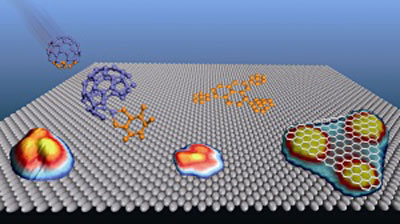| Jul 20, 2011 |
Spherical carbon molecules can make perfectly formed quantum dots
|
|
(Nanowerk News) Carbon nanostructures come in all shapes and sizes, each with its own set of unique properties. This diversity, combined with its low-cost and natural abundance, has made carbon one of the most exciting material prospects. Key to its success is the simplicity with which structures can be fabricated. Scientists from the A*STAR Institute of High Performance Computing and the National University of Singapore have now developed a technique that collapses spherical carbon nanostructures down into perfectly formed quantum dots—structures useful for electronics because of their ability to trap single electrons ("Transforming C60 molecules into graphene quantum dots").
|
 |
| Buckyballs can be converted into graphene quantum dots by heating them on a ruthenium substrate.
|
|
The carbon atoms in graphite are arranged into stacked sheets that are weakly bound to one another. A single layer, referred to as graphene, can be peeled from bulk graphite using adhesive tape. The properties of graphene differ radically from the bulk material because it is only one atom thick, and so scientists are keen to harness this potential in a form compatible with existing optical and electronic devices. Small, regular-shaped graphene nanostructures called quantum dots, for example, could open up new possibilities in such applications.
|
|
Quantum dots, at just a few nanometers in diameter, can influence the flow of current at the single-electron level. However, making lots of quantum dots all with the same dimensions, and therefore with the same electronic properties, has proved to be tricky. The researchers came up with a simple solution: they took a hollow spherical form of carbon known as a 'buckyball'—which is composed of 60 carbon atoms and always has the same shape—and fragmented it to produce uniformly sized quantum dots of graphene (see image).
|
|
The researchers deposited their buckyballs onto a ruthenium surface to catalyze the fragmentation. On heating to 725 kelvin, the carbon atoms rearranged from a sphere into a flower shape. At 825 kelvin, these dots merged into a single quantum dot 1.2 nanometers across. "We discovered that only with a low coverage of buckyballs on ruthenium would the carbon fragments diffuse across the metal substrate and form regular-size nanographene structures," the researchers explain. They believe that the shape of the graphene dots can be tailored by optimizing the annealing temperature and density of the carbon clusters.
|
|
"The next step in the research will be to devise ways to extract these interesting nanostructures from the ruthenium and transfer them to a semiconducting substrate for further experiments," say the researchers.
|

